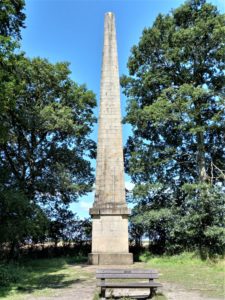One of our 2020 Christmas Presents was a book called ‘Beyond the end of the line’ containing 26 walks from the outer ends of various London Underground stations. Covid meant it remained unused, but when we felt ready to venture forth, we chose a walk from Cockfosters, at the northern end of the Piccadilly Line.
Starting at the station, we used the easy-to-follow directions to “Trent Country Park”:http://www.trentcountrypark.com/Welcome.html which we read was a remnant of the ancient royal hunting ground of Enfield Chase. Both cars and pedestrians were streaming down the narrow track from the main road, and we became a little concerned at how busy it would be. However, having passed rapidly filling car parks, “Go Ape”:https://goape.co.uk/locations/cockfosters and a busy café with lots of outdoor seating, we were soon heading through dappled forests which, apart from the odd dog walker, we had to ourselves.
The circular 4-mile route was easy to follow and included a diversion off to the Water Garden. This was a sunken patchwork of paths and pools originally set out in the late 1920s by Sir Philip Sassoon, the flamboyant owner of Trent Park from 1912 to 1939.
On the nearby lake, rare and expensive species of waterfowl would have been fed by Sir Philip using food ordered in from London Zoo. Sadly, there are now the more common types of birds and you’re unable to walk right around the lake, but young children were dipping nets into the water to try to catch fish.
On the opposite side of the lake was the original Trent Park House which had been partially rebuilt by Sir Phillip in 1926 using bricks from Devonshire House in Piccadilly. During World War II, it housed captured German officers who did not realise their conversations were being listened to. It then became part of the Middlesex University Campus but is now being developed for private housing.
During our walk we also passed by the Ancient Monument, Camlet Moat, although according to our book, nothing is known of the origins and the name, Camlet, is a mystery. We could only walk along two sides of the square-shaped moat, with its stagnant green water, due to thick undergrowth, and because of trees, it was hard to imagine what would have been on the site.
It was hard to miss the Sassoon Obelisk: a tall thin pillar inscribed with the words, ‘To the memory of the birth of George Grey, Earl of Harold, son of Henry and Sofia, Duke and Duchess of Kent 1702’. The Obelisk was originally sited in Wrest Park, Bedfordshire but was moved by Sir Philip in 1934 in order to impress the Duke and Duchess of Kent, honeymooning at the estate. A channel was carved through the forest to afford a grand view of the monument from Trent Park House.
The walk took around 2 hours in total as we didn’t rush and stopped frequently for photographs and to sit on one of the many seats to admire the views.
The book suggested refreshments in either the café, or the nearby Cock Inn which we retired to bearing in mind the number of families at the café.
If you live in or around London, I’d highly recommend the book “Beyond the end of the line” by Jeff Lock, Trent Park and the Cock Inn.








